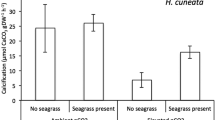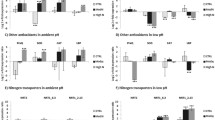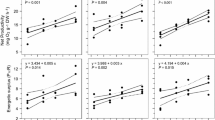Abstract
Ocean acidification is thought to benefit seagrasses because of increased carbon dioxide (CO2) availability for photosynthesis. However, in order to truly assess ecological responses, effects of ocean acidification need to be investigated in a variety of coastal environments. We tested the hypothesis that ocean acidification would benefit seagrasses in the northern Gulf of Mexico, where the seagrasses Halodule wrightii and Ruppia maritima coexist in a fluctuating environment. To evaluate if benefits of ocean acidification could alter seagrass bed composition, cores of H. wrightii and R. maritima were placed alone or in combination into aquaria and maintained in an outdoor mesocosm. Half of the aquaria were exposed to either ambient (mean pH of 8.1 ± 0.04 SD on total scale) or high CO2 (mean pH 7.7 ± 0.05 SD on total scale) conditions. After 54 days of experimental exposure, the δ13C values were significantly lower in seagrass tissue in the high CO2 condition. This integration of a different carbon source (either: preferential use of CO2, gas from cylinder, or both) indicates that plants were not solely relying on stored energy reserves for growth. Yet, after 41 to 54 days, seagrass morphology, biomass, photo-physiology, metabolism, and carbon and nitrogen content in the high CO2 condition did not differ from those at ambient. There was also no indication of differences in traits between the homospecific or heterospecific beds. Findings support two plausible conclusions: (1) these seagrasses rely heavily on bicarbonate use and growth will not be stimulated by near future acidification conditions or (2) the mesohaline environment limited the beneficial impacts of increased CO2 availability.







Similar content being viewed by others
References
Adair, S.E., Joseph L. Moore, and P.O. Christopher. 1994. Distribution and status of submerged vegetation in estuaries of the upper Texas coast. Wetlands 14 (2): 110–121. https://doi.org/10.1007/BF03160627.
Anton, A., J. Cebrian, C.M. Duarte, K.L. Heck Jr., and J. Goff. 2009. Low impact of Hurricane Katrina on seagrass community structure and functioning in the northern Gulf of Mexico. Bull Mar Sci 85: 45–59.
Anton, A., J. Cebrian, K.L. Heck, C.M. Duarte, K.L. Sheehan, M.E.C. Miller, and D. Foster. 2011. Decoupled effects (positive to negative) of nutrient enrichment on ecosystem services. Ecol Appl 21 (3): 991–1009. https://doi.org/10.1890/09-0841.1.
Apostolaki, E.T., S. Vizzini, I.E. Hendriks, and Y.S. Olsen. 2014. Seagrass ecosystem response to long-term high CO2 in a Mediterranean volcanic vent. Marine environmental research Elsevier Ltd 99: 9–15. https://doi.org/10.1016/j.marenvres.2014.05.008.
Aufdenkampe, A.K., E. Mayorga, P.A. Raymond, J.M. Melack, S.C. Doney, S.R. Alin, R.E. Aalto, and K. Yoo. 2011. Riverine coupling of biogeochemical cycles between land, oceans, and atmosphere. Front Ecol Environ 9: 53–60. https://doi.org/10.1890/100014.
Beer, S., and M. Björk. 2000. Measuring rates of photosynthesis of two tropical seagrasses by pulse amplitude modulated (PAM) fluorometry. Aquat Bot 66: 69–76. https://doi.org/10.1016/S0304-3770(99)00020-0.
Beer, S., A. Eshel, and Y. Waisel. 1977. Carbon metabolism in seagrasses. J Exp Bot 28: 1180–1189. https://doi.org/10.1093/jxb/28.5.1180.
Benjamini, Y., and Y. Hochberg. 1995. Controlling the false discovery rate: A practical and powerful approach to multiple testing. Journal of the Royal Statistical Society Series B 57: 289–300. https://doi.org/10.2307/2346101.
Bird, K.T., J. Jewett-Smith, and M.S. Fonseca. 2016. Use of in vitro propagated Ruppia maritima for seagrass meadow restoration. J Coast Res 10: 732–737.
Britton, D., C.E. Cornwall, A.T. Revill, C.L. Hurd, and C.R. Johnson. 2016. Ocean acidification reverses the positive effects of seawater pH fluctuations on growth and photosynthesis of the habitat-forming kelp, Ecklonia radiata. Sci Rep 6: 26036. https://doi.org/10.1038/srep26036.
Buapet, P., L.M. Rasmusson, M. Gullström, and M. Björk. 2013. Photorespiration and carbon limitation determine productivity in temperate seagrasses. PLoS One 8: 1–9. https://doi.org/10.1371/journal.pone.0083804.
Burnell, O.W., B.D. Russell, A.D. Irving, and S.D. Connell. 2014. Seagrass response to CO2 contingent on epiphytic algae: Indirect effects can overwhelm direct effects. Oecologia 176 (3): 871–882. https://doi.org/10.1007/s00442-014-3054-z.
Campbell, J.E., and J.W. Fourqurean. 2011. Novel methodology for in situ carbon dioxide enrichment of benthic ecosystems. Limnol Oceanogr Methods 9: 97–109. https://doi.org/10.4319/lom.2011.9.97.
Campbell, J.E., and J.W. Fourqurean. 2013a. Mechanisms of bicarbonate use influence the photosynthetic carbon dioxide sensitivity of tropical seagrasses. Limnol Oceanogr 58: 839–848. https://doi.org/10.4319/lo.2013.58.3.0839.
Campbell, J.E., and J.W. Fourqurean. 2013b. Effects of in situ CO2 enrichment on the structural and chemical characteristics of the seagrass Thalassia testudinum. Mar Biol 160: 1465–1475. https://doi.org/10.1007/s00227-013-2199-3.
Campbell, J.E., and J.W. Fourqurean. 2018. Does nutrient availability regulate seagrass response to elevated CO2? Ecosystems Springer US 21: 1269–1282. https://doi.org/10.1007/s10021-017-0212-2.
Cebrian, J., A.A. Corcoran, A.L. Stutes, J.P. Stutes, and J.R. Pennock. 2009. Effects of ultraviolet-B radiation and nutrient enrichment on the productivity of benthic microalgae in shallow coastal lagoons of the North Central Gulf of Mexico. J Exp Mar Biol Ecol 372: 9–21. https://doi.org/10.1016/j.jembe.2009.02.009.
Cebrian, J., J.P. Stutes, and B. Christiaen. 2013. Effects of grazing and fertilization on epiphyte growth dynamics under moderately eutrophic conditions: Implications for grazing rate estimates. Mar Ecol Prog Ser 474: 121–133. https://doi.org/10.3354/meps10092.
Cho, H.J., and C.A. May. 2008. Short-term spatial variations in the beds of Ruppia maritima (ruppiaceae) and Halodule wrightii (cymodoceaceae) at Grand Bay National Estuarine Research Reserve, Mississippi, USA. Journal of the Mississippi Academy of Sciences 53: 2–3.
Cho, H.J., and M.A. Poirrier. 2005. Seasonal growth and reproduction of Ruppia maritima L. s.l. in Lake Pontchartrain, Louisiana, USA. Aquat Bot 81: 37–49. https://doi.org/10.1016/j.aquabot.2004.10.002.
Christiaen, B., J.C. Lehrter, J. Goff, and J. Cebrian. 2016. Functional implications of changes in seagrass species composition in two shallow coastal lagoons. Mar Ecol Prog Ser 557: 111–121. https://doi.org/10.3354/meps11847.
Collier, C.J., L. Langlois, Y. Ow, C. Johansson, M. Giammusso, M.P. Adams, K.R. O’Brien, and S. Uthicke. 2018. Losing a winner: Thermal stress and local pressures outweigh the positive effects of ocean acidification for tropical seagrasses. New Phytol 219 (3): 1005–1017. https://doi.org/10.1111/nph.15234.
Connell, S.D., K.J. Kroeker, K.E. Fabricius, D.I. Kline, and B.D. Russell. 2013. The other ocean acidification problem: CO2 as a resource among competitors for ecosystem dominance. Philosophical Transactions of the Royal Society B: Biological Sciences 368 (1627): 20120442–20120442. https://doi.org/10.1098/rstb.2012.0442.
Cox, T.E., S. Schenone, J. Delille, V. Díaz-Castañeda, S. Alliouane, J.P. Gattuso, and F. Gazeau. 2015. Effects of ocean acidification on Posidonia oceanica epiphytic community and shoot productivity. J Ecol 103: 1594–1609. https://doi.org/10.1111/1365-2745.12477.
Cox, T.E., F. Gazeau, S. Alliouane, I.E. Hendriks, P. Mahacek, A. Le Fur, and J. Pierre Gattuso. 2016. Effects of in situ CO2 enrichment on structural characteristics, photosynthesis, and growth of the Mediterranean seagrass Posidonia oceanica. Biogeosciences 13: 2179–2194. https://doi.org/10.5194/bg-13-2179-2016.
Doering, P.H., R.H. Chamberlain, and D.E. Haunert. 2002. Using submerged aquatic vegetation to establish minimum and maximum freshwater inflows to the Caloosahatchee estuary, Florida. Estuaries 25: 1343–1354. https://doi.org/10.1007/BF02692229.
Duarte, C.M., and J. Cebrián. 1996. The fate of marine autotrophic production. Limnol Oceanogr 41: 1758–1766. https://doi.org/10.4319/lo.1996.41.8.1758.
Duarte, C.M., and C.L. Chiscano. 1999. Seagrass biomass and production: A reassessment. Aquat Bot 65: 159–174. https://doi.org/10.1016/S0304-3770(99)00038-8.
Duarte, C.M., N. Marbà, E. Gacia, J.W. Fourqurean, J. Beggins, C. Barrón, and E.T. Apostolaki. 2010. Seagrass community metabolism: Assessing the carbon sink capacity of seagrass meadows. Glob Biogeochem Cycles 24: N/a–n/a. https://doi.org/10.1029/2010GB003793.
Duarte, C.M., I.E. Hendriks, T.S. Moore, Y.S. Olsen, A. Steckbauer, L. Ramajo, J. Carstensen, J.A. Trotter, and M. McCulloch. 2013. Is ocean acidification an open-ocean syndrome? Understanding anthropogenic impacts on seawater pH. Estuar Coasts 36: 221–236. https://doi.org/10.1007/s12237-013-9594-3.
Duffy, J. Emmett. 2006. Biodiversity and the functioning of seagrass ecosystems. Mar Ecol Prog Ser 311: 233–250. https://doi.org/10.3354/meps311233.
Dunton, K.H. 1990. Production ecology of Ruppia maritima L. s.l. and Halodule wrightii Aschers, in two subtropical estuaries. J Exp Mar Biol Ecol 143: 147–164. https://doi.org/10.1016/0022-0981(90)90067-M.
Dunton, K.H. 1996. Photosynthetic production and biomass of the subtropical seagrass Halodule wrightii along an estuarine gradient. Estuaries 19 (2): 436–447. https://doi.org/10.2307/1352461.
Durako, M.J. 1993. Photosynthetic utilization of CO2(aq) and HCO3− in Thalassia testudinum (Hydrocharitaceae). Mar Biol 115 (3): 373–380. https://doi.org/10.1007/BF00349834.
Elderfield, H., O. Hoegh-Guldberg, P. Liss, U. Riebesell, J. Shepherd, C. Turley, and A. Watson. 2005. Ocean acidification due to increasing atmospheric carbon dioxide. The Royal Society 68.
Frieder, C.A., J.P. Gonzalez, E.E. Bockmon, M.O. Navarro, and L.A. Levin. 2014. Can variable pH and low oxygen moderate ocean acidification outcomes for mussel larvae? Glob Chang Biol 20 (3): 754–764. https://doi.org/10.1111/gcb.12485.
Gallegos, M.E., M. Merino, A. Rodriguez, N. Marba, and C.M. Duarte. 1994. Growth patterns and demography of pioneer Caribbean seagrasses Halodule wrightii and Syringodium filiforme. Mar Ecol Prog Ser 109: 99. https://doi.org/10.3354/meps109099.
Gattuso J. P., J. M. Epitalon, H. Lavigne, J. Orr, B. Gentili, A. Hofmann, J. D. Muelle, A. Proye, J. Rae, and S. Karline. 2018. Package ‘seacarb’. http://CRAN.R-project.org/package=seacarb. Accessed 25 Oct 2019.
Genty, B., J.M. Briantais, and N.R. Baker. 1989. The relationship between the quantum yield of photosynthetic electron transport and quenching of chlorophyll fluorescence. Biochimica et Biophysica Acta - General Subjects Elsevier Science Publishers BV (Biomedical Division) 990: 87–92. https://doi.org/10.1016/S0304-4165(89)80016-9.
Gustafsson, C., and C. Boström. 2011. Biodiversity influences ecosystem functioning in aquatic angiosperm communities. Oikos 120: 1037–1046. https://doi.org/10.1111/j.1600-0706.2010.19008.x.
Gustafsson, C., and C. Boström. 2013. Influence of neighboring plants on shading stress resistance and recovery of eelgrass, Zostera marina L. PLoS ONE 8. https://doi.org/10.1371/journal.pone.0064064.
Hall-Spencer, J.M., R. Rodolfo-Metalpa, S. Martin, E. Ransome, M. Fine, S.M. Turner, S.J. Rowley, D. Tedesco, and M.C. Buia. 2008. Volcanic carbon dioxide vents show ecosystem effects of ocean acidification. Nature 454 (7200): 96–99. https://doi.org/10.1038/nature07051.
Hemminga, M.A., and C.M. Duarte. 2000. Seagrass ecology. Cambridge: Cambridge University Press. https://doi.org/10.1017/CBO9780511525551.
Hemminga, M.A., and M.A. Mateo. 1996. Stable carbon isotopes in seagrasses: Variability in ratios and use in ecological studies. Mar Ecol Prog Ser 140: 285–298. https://doi.org/10.3354/meps140285.
Hendriks, I.E., Y.S. Olsen, and C.M. Duarte. 2017. Light availability and temperature, not increased CO2, will structure future meadows of Posidonia oceanica. Aquatic Botany Elsevier BV 139: 32–36. https://doi.org/10.1016/j.aquabot.2017.02.004.
Hofmann, G.E., J.E. Smith, K.S. Johnson, U. Send, L.A. Levin, F. Micheli, A. Paytan, N.N. Price, B. Peterson, Y. Takeshita, P.G. Matson, E.D. Crook, K.J. Kroeker, M.C. Gambi, E.B. Rivest, C.A. Frieder, P.C. Yu, and T.R. Martz. 2011. High-frequency dynamics of ocean pH: A multi-ecosystem comparison. PLoS One 6 (12): e28983. https://doi.org/10.1371/journal.pone.0028983.
Invers, O., R.C. Zimmerman, R.S. Alberte, M. Pérez, and J. Romero. 2001. Inorganic carbon sources for seagrass photosynthesis: An experimental evaluation of bicarbonate use in species inhabiting temperate waters. J Exp Mar Biol Ecol 265: 203–217. https://doi.org/10.1016/S0022-0981(01)00332-X.
Invers, O., M. Pérez, and J. Romero. 2002. Seasonal nitrogen speciation in temperate seagrass Posidonia oceanica (L.) Delile. J Exp Mar Biol Ecol 273: 219–240.
IPCC Climate Change. 2013. 2013: The Physical Science Basis. Contribution of Working Group I to the Fifth Assessment Report of the Intergovernmental Panel on Climate Change. Cambridge: Cambridge University Press.
Jiang, Z.J., X.P. Huang, and J.P. Zhang. 2010. Effects of CO2 enrichment on photosynthesis, growth, and biochemical composition of seagrass Thalassia hemprichii (Ehrenb.) Aschers. J Integr Plant Biol 52 (10): 904–913. https://doi.org/10.1111/j.1744-7909.2010.00991.x.
Kantrud, H.A. 1991. Wigeongrass (Ruppia maritima): A literature review. United States Department of the Interior, Fish and Wildlife Service 10. Jamestown: Northern Prairie Wildlife Research Center Home Page. http://www.npwrc.usgs.gov/resource/literatr/ruppia/ruppia.htm.
Kilminster, K., K. McMahon, M. Waycott, G.A. Kendrick, P. Scanes, L. McKenzie, K.R. O’Brien, et al. 2015. Unravelling complexity in seagrass systems for management: Australia as a microcosm. Science of the Total Environment Elsevier BV 534: 97–109. https://doi.org/10.1016/j.scitotenv.2015.04.061.
Koch, M., G. Bowes, C. Ross, and X.H. Zhang. 2013. Climate change and ocean acidification effects on seagrasses and marine macroalgae. Glob Chang Biol 19 (1): 103–132. https://doi.org/10.1111/j.1365-2486.2012.02791.x.
Kroopnick, P.M. 1985. The distribution of 13C of ΣCO2 in the world oceans. Deep Sea Research Part A Oceanographic Research Papers 32: 57–84. https://doi.org/10.1016/0198-0149(85)90017-2.
Martínez-Crego, B., I. Olivé, and R. Santos. 2014. CO2 and nutrient-driven changes across multiple levels of organization in Zostera noltii ecosystems. Biogeosciences 11: 7237–7249. https://doi.org/10.5194/bg-11-7237-2014.
Moriarty, D.J.W., R.L. Iverson, and P.C. Pollard. 1986. Exudation of organic carbon by the seagrass Halodule wrightii Aschers. and its effect on bacterial growth in the sediment. J Exp Mar Biol Ecol 96: 115–126. https://doi.org/10.1016/0022-0981(86)90237-6.
Olivé, I., J. Silva, C. Lauritano, M.M. Costa, M. Ruocco, G. Procaccini, and R. Santos. 2017. Linking gene expression to productivity to unravel long- and short-term responses of seagrasses exposed to CO2 in volcanic vents. Scientific Reports Nature Publishing Group 7: 42278. https://doi.org/10.1038/srep42278.
Ow, Y.X., C.J. Collier, and S. Uthicke. 2015. Responses of three tropical seagrass species to CO2 enrichment. Mar Biol 162: 1005–1017. https://doi.org/10.1007/s00227-015-2644-6.
Pacella, S.R., C.A. Brown, G.G. Waldbusser, R.G. Labiosa, and B. Hales. 2018. Seagrass habitat metabolism increases short-term extremes and long-term offset of CO2 under future ocean acidification. Proc Natl Acad Sci U S A 115 (15): 3870–3875. https://doi.org/10.1073/pnas.1703445115.
Pajusalu, L., G. Martin, Tiina Paalme, and A. Põllumäe. 2016. The effect of CO2 enrichment on net photosynthesis of the red alga Furcellaria lumbricalis in a brackish water environment. PeerJ 4: 1–21. https://doi.org/10.7717/peerj.2505.
Palacios, S.L., and R.C. Zimmerman. 2007. Response of eelgrass Zostera marina to CO2 enrichment: Possible impacts of climate change and potential for remediation of coastal habitats. Mar Ecol Prog Ser 344: 1–13. https://doi.org/10.3354/meps07084.
Platt, T., C.L. Gallegos, and W.G. Harrison. 1980. Photoinibition of photosynthesis in natural assemblages of marine phytoplankton. Journal of Marine Research (USA) 38: 687–701.
Poorter, H., and M.L. Navas. 2003. Plant growth and competition at elevated CO2: On winners, losers and functional groups. New Phytol 157: 175–198. https://doi.org/10.1046/j.1469-8137.2003.00680.x.
Pulich, W.M. 1985. Seasonal growth dynamics of Ruppia maritima L.s.l. and Halodule wrightii Aschers. in Southern Texas and evaluation of sediment fertility status. Aquat Bot 23: 53–66. https://doi.org/10.1016/0304-3770(85)90020-8.
Ralph, P.J., and R. Gademann. 2005. Rapid light curves: A powerful tool to assess photosynthetic activity. Aquat Bot 82: 222–237. https://doi.org/10.1016/j.aquabot.2005.02.006.
Russell, B.D., S.D. Connell, S. Uthicke, N. Muehllehner, K.E. Fabricius, and J.M. Hall-Spencer. 2013. Future seagrass beds: Can increased productivity lead to increased carbon storage? Marine Pollution Bulletin Elsevier Ltd 73: 463–469. https://doi.org/10.1016/j.marpolbul.2013.01.031.
Sand-Jensen, K., and D.M. Gordon. 1984. Differential ability of marine and freshwater macrophytes to utilize HCO3− and CO2. Mar Biol 80 (3): 247–253. https://doi.org/10.1007/BF00392819.
Schneider, G., P.A. Horta, E.N. Calderon, C. Castro, A. Bianchini, C.R.A. da Silva, I. Brandalise, J.B. Barufi, J. Silva, and A.C. Rodrigues. 2018. Structural and physiological responses of Halodule wrightii to ocean acidification. Protoplasma 255 (2): 629–641. https://doi.org/10.1007/s00709-017-1176-y.
Takeshita, Y., C.A. Frieder, T.R. Martz, J.R. Ballard, R.A. Feely, S. Kram, S. Nam, M.O. Navarro, N.N. Price, and J.E. Smith. 2015. Including high-frequency variability in coastal ocean acidification projections. Biogeosciences 12: 5853–5870. https://doi.org/10.5194/bg-12-5853-2015.
Underwood, A.J. 1997. Experiments in ecology: Their logical design and interpretation using analysis of variance. Cambridge: Cambridge University Press.
Waldbusser, G.G., and J.E. Salisbury. 2014. Ocean acidification in the coastal zone from an organism’s perspective: Multiple system parameters, frequency domains, and habitats. Annu Rev Mar Sci 6: 221–247. https://doi.org/10.1146/annurev-marine-121211-172238.
Welschmeyer, N.A. 1994. Fluorometric analysis of chlorophyll a in the presence of chlorophyll b and pheopigments. Limnol Oceanogr 39: 1985–1992. https://doi.org/10.4319/lo.1994.39.8.1985.
Zimmerman, R.C., D.G. Kohrs, D.L. Steller, and R.S. Alberte. 1997. Impacts of CO2 enrichment on productivity and light requirements of eelgrass. Plant Physiol 115 (2): 599–607. https://doi.org/10.1104/pp.115.2.599.
Zimmerman, R.C., V.J. Hill, M. Jinuntuya, B. Celebi, D. Ruble, M. Smith, T. Cedeno, and W.M. Swingle. 2017. Experimental impacts of climate warming and ocean carbonation on eelgrass Zostera marina. Mar Ecol Prog Ser 566: 1–15. https://doi.org/10.3354/meps12051.
Acknowledgments
We would like to acknowledge the construction assistance from Dauphin Island Technical Support. We also are grateful to Josh Goff, Laura West, Adam Chastan, Emory Lan, and Andrew Moorehead for their help collecting seagrass cores and assisting with data collection. Lastly, we kindly thank Tom Gouba and Jonathan Whittman for sharing dock space and removal of the system. We also thank Samir Alliouane and Dr. Jean-Pierre Gattuso for providing us technical advice and equipment. In addition, we also want to thank the useful comments from two anonymous reviewers greatly improved the quality of this manuscript.
Author information
Authors and Affiliations
Corresponding author
Additional information
Communicated by Masahiro Nakaoka
Rights and permissions
About this article
Cite this article
Guerrero-Meseguer, L., Cox, T.E., Sanz-Lázaro, C. et al. Does Ocean Acidification Benefit Seagrasses in a Mesohaline Environment? A Mesocosm Experiment in the Northern Gulf of Mexico. Estuaries and Coasts 43, 1377–1393 (2020). https://doi.org/10.1007/s12237-020-00720-5
Received:
Revised:
Accepted:
Published:
Issue Date:
DOI: https://doi.org/10.1007/s12237-020-00720-5




